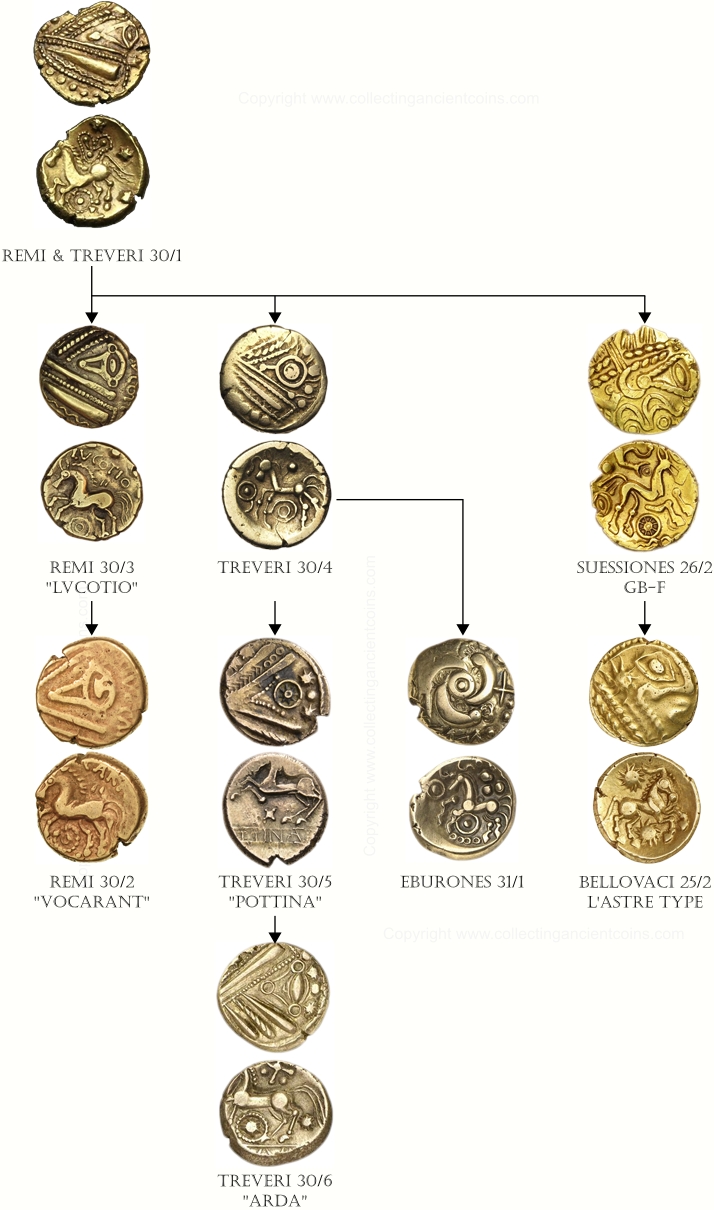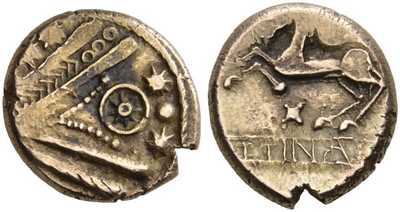| Back to Gallo Belgic F and Gallo Belgic G | This page is part of the article Getting Started with Celtic Coins | Forward to Coins of the Parisii |
The Gallo-Belgic E coins we discussed earlier are well known as the Gallic War staters. These were not, however, the only staters minted in response to the war. The tribes allied with the Romans also minted coins to cover expenses, and these are known as the Eye Staters. These coins were ultimately inspired by the Philippus, but begin with just the remnants of Apollo’s head in a highly abstracted form. While Gallo-Belgic C focussed on Apollo’s hair and wreath, these coins focus on Apollo’s eye and wreath.
The Eye Staters are centred round a set of coins known as Scheers series 30 (see “La Gaule Belgique - Traité De Numismatique Celtique”), consisting of six classes, and having links to several other types of coins. Class 1 alone is thought to have consisted of several millions coins.
Photo copyrights: 25/2 Nomos AG; 26/2 Comptoir des Monnaies; 30/1 Mike Vosper Coins; 30/2 Comptoir des Monnaies; 30/3 © Trustees of the British Museum (CC BY-NC-SA 4.0); 30/4 Jean ELSEN & ses Fils s.a.; 30/5 Hess Divo AG; 30/6 Fritz Rudolf Künker GmbH & Co. KG, Osnabrück; Lübke & Wiedemann KG, Leonberg; 31/1 Paul-Francis Jacquier
There are a number of complexities with the Series 30 coins that form the core of the Eye Staters that mean our understanding of these coins is still evolving. The latest and most comprehensive work was published by Dr. John Sills in “Reversal of fortune : eye staters of the Remi and Treveri”. It’s well worth getting a copy if you are interested in these coin. The rest of this discussion is based on his work, but expand the box below if you want to know some of the problems and previous theories about the coins.
The Eye Staters began with the Remi, and the Scheers 30 class 1 coins:
Copyright Mike Vosper Coins
At the start of the war the Remi were under the control of the Suessiones, a situation that was reversed when the Suessiones were defeated in 57 BC and the Remi allied with Rome. The Remi probably started minting the coins at this point. Shortly after, the Remi’s neighbours, the Treveri, also started minting Eye Staters of the Scheers 30 class 1 type. The Treveri were one of the strongest Gaulish tribes and were allied to Rome at the start of the war, although they had a history of changing sides when it suited them. Class 1 of the series 30 Eye Staters was the largest of the classes, and was probably needed by these tribes to cover the costs of the Belgic campaign in 57 BC.
It’s possible that this is the point where the Suessiones, now under the control of the Remi, started minting Gallo-Belgic F with an eye on it:
Copyright Comptoir des Monnaies
Gallo-Belgic F started life (for only one die) with a fairly standard obverse derived from Gallo-Belgic C. The eye copied from the Remi Eye Staters was a later addition.
As the war progressed, the coins from the Remi and Treveri diverged. The Remi classes 2 and 3 carry the legends “Vocarant” and “Lvcotios”. An analysis of the metal content suggests that class 3 (Lvcotios) was minted before class 2 (Vocarant):
Copyright Comptoir des Monnaies
Copyright © Trustees of the British Museum (CC BY-NC-SA 4.0)
Although both classes seem to have been similar in size, the class 3 coins (Lvcotios) are found over a large area whereas the class 2 coins (Vocarant) are only known from a few find spots. One theory is that class 3 might have been minted to pay Gallic cavalry, and class 2 to pay tribute to someone (possibly Rome). Both classes are likely to have been minted around 54 to 53 BC when Labienus and his troops were stationed with the Remi to campaign against the Treveri, Senones and Parisii. Lvcotios and Vocarant are likely to have been magistrates rather than chiefs.
The Treveri on the other hand came under the rule of Indutiomarus who switched sides and rose up against the Romans in 54 BC. The class 4 coins of series 30 are thought to be related to this military action.
Copyright Jean ELSEN & ses Fils s.a.
In 53 BC the Treveri hired Germanic mercenaries which is possibly the reason why the Eburones, a client of the Treveri, started minting coins with a Germanic Triskeles on the obverse, and a series 30 class 4 reverse. These are known as Scheers series 31 coins:
Copyright Paul-Francis Jacquier
The last two Treveri Eye Staters, series 30 classes 5 and 6, carry the legends “Pottina” and “Arda” respectively:
Copyright Hess Divo AG
Copyright Fritz Rudolf Künker GmbH & Co. KG, Osnabrück; Lübke & Wiedemann KG, Leonberg
The Pottina coins were struck in 53 or 52 BC, and the Arda coins were struck sometime between 52 and 50 BC. The reasons for striking these coins aren’t known, but they were possibly to cover the costs of fighting the Germanic tribes in 52 BC, or to pay the same Germans who were now helping them fight the Romans in 51 BC.
Finally, there’s a series of tri-metallic coins from the Bellovaci known as “à l’astre” staters (star staters) that appear to be inspired by the eye on Gallo-Belgic F, and possibly the star on Gallo-Belgic G and the reversed S on the later Gallo-Belgic E coins:
Copyright Nomos AG
Further Reading
The definitive work on these coins is by Dr. John Sills in his paper “Reversal of fortune : eye staters of the Remi and Treveri”, published in “De Nummis Gallicis – Mélanges de numismatique celtique offerts à Louis-Pol Delestrée”. It’s essential reading if you are interested in learning more about these coins.
The data on the coins mentioned in this section in Scheers’ book “La Gaule Belgique - Traité De Numismatique Celtique” is still relevant today, even though her theory is no longer considered correct. The book is in French, so be prepared to spend some time translating it if you can’t read French.
Article Navigation
| Back to Gallo Belgic F and Gallo Belgic G | Up to Third Generation Coins (c. 125 BC to c. 50 BC) | Forward to Coins of the Parisii |










